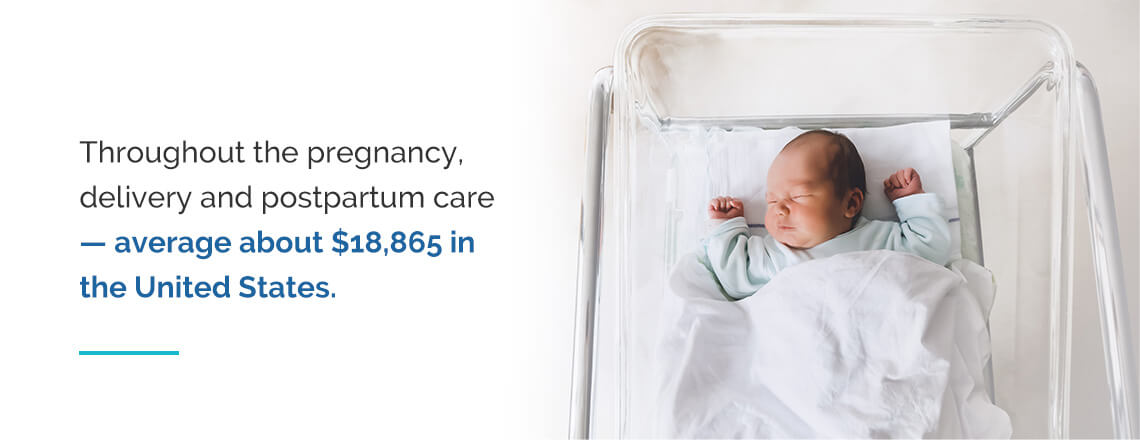Health Insurance Options for Pregnant Women in California
Posted: March 22, 2023

Health Insurance Options for Pregnant Women
If you’re pregnant or looking to get pregnant, considering your health insurance coverage is crucial. It’ll affect what kind of care you can get and how easy it is to pay for that care. Fortunately, you have options.
Most major health insurance plans must cover maternity and newborn care, even if you’re pregnant when you enroll in the plan. Another popular option is Medicaid, and income limits are higher for pregnant women, so you may qualify even if you’d normally make too much for the program.
Learn all about health insurance for pregnant women, including frequently asked questions and a guide to enrolling in Medicaid and health insurance plans.
What Does Health Insurance Cover for Pregnancy?
Thanks to the Affordable Care Act (ACA), maternity and newborn care is considered an essential health benefit, which means it must be covered by all qualified health plans. Medicaid and any plan you get through a federal or state-run Health Insurance Marketplace will cover these services. While other non-Marketplace plans will also provide coverage, Marketplace plans often reduce the cost of your premiums with a subsidy.
Specific coverage may vary by plan, though you can generally expect coverage for the following services:
- Outpatient services, such as prenatal and postnatal doctor’s visits, health screenings, medications or labwork.
- Inpatient services, including hospitalization and physician’s fees.
- Newborn baby care.
- Lactation counseling and equipment.
Many parts of pregnancy, including well-baby checkups, prenatal visits, screening tests and blood tests are considered preventative care and will be covered without any out-of-pocket payments, like co-insurance or co-payments. Check your plan’s summary of benefits for details on specific costs. If you’re shopping for a plan, you can view this information ahead of time, too.
Is Pregnancy Considered a Preexisting Condition?
Pregnancy is considered a preexisting condition, but all ACA-compliant plans must cover preexisting conditions. Therefore, this distinction is mostly irrelevant when you buy major medical insurance or apply for Medicare. If you buy short-term insurance, which we’ll discuss later, an existing pregnancy can make you ineligible for coverage.
How Much Does It Cost to Give Birth?

The medical costs associated with giving birth — throughout the pregnancy, delivery and postpartum care — average about $18,865 in the United States. Cesarean sections (C-sections) cost about $26,280, and complicated or high-risk pregnancies can increase costs. Insurance greatly reduces average costs to just under $2,900. These numbers don’t include fertility care or over-the-counter drugs such as prenatal vitamins.
If you see out-of-network providers, your costs could be much higher. Be sure to check with your plan and understand which services and providers are covered and how much your out-of-pocket costs will be.
In the past, you might have received unexpected bills if you checked into an in-network hospital where an out-of-network provider, such as the person administering anesthesia, treated you. In 2022, the No Surprises Act went into effect, so you can no longer be charged extra for out-of-network services delivered at an in-network facility. It also protects you from higher costs from out-of-network air ambulance services.
Maternity Health Insurance Options
Whether you’re already pregnant or are looking to become pregnant, you have a few different options for getting covered.
Major Health Insurance Plans
You can sign up for most major health insurance plans, including those on the Marketplace, during open enrollment periods or if you experience a qualifying life event. Open enrollment periods allow anyone to freely switch or sign up for plans. This period generally occurs between November and mid-January, but if you want your coverage to start on January 1, you’ll need to sign up by December 15.
Qualifying life events are things like losing employer-based coverage, moving to a new state or getting married, which would grant you a special enrollment period to change or sign up for a plan. Becoming pregnant isn’t a qualifying life event, but giving birth — which changes your family structure — is a qualifying event. After giving birth, you can enroll in a plan, switch plans or add your new baby to your current plan. Without a qualifying life event or open enrollment, you won’t be able to make changes before delivery.
With a health insurance plan, you’ll typically receive the pregnancy-related benefits mentioned above along with standard medical benefits. You may need to see a doctor within your insurance provider’s network to receive coverage for certain services.
Medicaid or CHIP
If you don’t have a qualifying life event or you missed open enrollment, you may still qualify for Medicaid or the Children’s Health Insurance Program (CHIP), even if your income is above the typical eligibility requirements.
Neither of these programs has enrollment periods, so you can qualify at any time. Both cover pregnancy benefits. In fact, qualified pregnant women are considered a mandatory eligibility group in all states, so any state-run Medicaid program must cover them.
Eligibility for Medicaid is typically based on income, but pregnancy opens up a few more options and expands the usual income limits. Here are some of the options you can find in California through the state’s Medi-Cal program:
- Full-scope Medi-Cal: Standard Medicaid eligibility is based on the federal poverty level (FPL). For instance, you might be eligible for Medi-Cal if your income is below 138% of the FPL. In 2022, that number was $27,750 for a four-person household.
- Medi-Cal for pregnancy: If you’re pregnant, you can become eligible for Medi-Cal if your income is below 213% of the poverty level, or $59,108 for a family of four. This program is available regardless of immigration status and offers postpartum coverage for up to one year after your pregnancy.
- The Medi-Cal Access Program: This program is available to pregnant individuals with incomes within 213%-322% of the poverty level, or $89,355 for a family of four. It also doesn’t consider immigration status and covers pregnancy-related care. It can even help if you have health insurance that doesn’t meet your needs or has too high of a payment.
CHIP is a program within Medicaid offering coverage to children whose families earn too much to qualify for Medicaid but still need assistance. In California, CHIP also offers health care for pregnancy. It can help you get coverage for your child after birth, too.
Even if you think you won’t qualify for Medicaid or CHIP, apply anyway. Pregnancy can make you more likely to fall under the “medically needy” category and help you get affordable coverage. We’ll discuss our Medicaid enrollment guide later on.
Medicare

Medicare is generally only available to people over 65 and younger people with disabilities. Still, if you’ve been receiving Social Security disability benefits for 24 months, you may be eligible and will automatically be enrolled after the 24 months is up.
Short-Term Health Insurance
Short-term health insurance has its place. It’s a good choice if you need to cover gaps in care, such as when you’re between jobs, but it usually isn’t a good choice for pregnancy coverage. It isn’t as comprehensive as a regular plan and generally won’t cover preexisting conditions, including pregnancy.
If you’re already pregnant, short-term plans won’t help you much. If you’re planning to get pregnant, they can still be limiting, so be cautious with this option and pay attention to benefits.
Other Ways to Reduce Costs
While insurance is always the best option, you may be able to save on the costs of having a child in other ways:
- Birth centers: Birth centers are appropriate for very low-risk births, offering a cozy environment and support from a midwife. Though they’re more affordable than hospitals, they provide a different level of care, which won’t be suitable for all births. They don’t offer epidurals, medications for pain, labor induction or intravenous medications.
- Low-cost maternity care: Organizations like Planned Parenthood, community health centers and Hill-Burton facilities may also be able to help you find low-cost maternity care.
- Hospital indemnity plans: Even with a good insurance plan, deductibles can be a significant expense. A hospital indemnity plan is a type of supplemental insurance that ensures you only pay a fixed amount per day during a hospitalization. These affordable plans can help combat high medical costs during hospitalizations when pregnant. They can also offset the financial challenges associated with missing work or paying for care while in the hospital.
Points to Consider When Enrolling in Maternity Insurance Plans
Buying insurance is complicated enough without pregnancy care. Keep the following aspects in mind while you shop for a maternity insurance plan:
- Referrals: Some plans won’t cover certain specialists, such as an OBGYN, without a referral. Know whether you’ll need one from your primary care physician before your visit.
- Prenatal testing: Your plan may or may not cover prenatal tests like ultrasounds and genetic testing. See what services are covered and whether you need preauthorization beforehand.
- Costs: Of course, you’ll want to know what your out-of-pocket costs will be. Consider your copays, coinsurance and deductibles. For example, if your coinsurance for a test is 40%, but you haven’t met your deductible, you may not receive any benefits for smaller expenses like prenatal visits and tests. When you visit the hospital for delivery, your costs could greatly exceed that deductible and limit your expenses to your out-of-pocket maximum.
- Private rooms: Think twice and consult your plan before you ask for a private room. Some plans won’t cover them at the same rates as shared rooms.
How to Enroll in Marketplace Health Insurance

If you, like many people, are looking for a health insurance plan on the Marketplace, the application process is straightforward and includes the following steps.
1. Find Your Enrollment Window
To sign up for a health insurance plan during open enrollment, set time aside between November 1 and January 15 to submit the application. If you need your coverage to start on January 1, get your application in by December 15. If you qualify for a special enrollment period, you can apply at any time.
2. Submit an Application
Before you sit down to fill out your application, collect some information. You’ll need:
- Basic personal information, such as your full name, date of birth and mailing address.
- Information about members of your household and anyone else applying for coverage.
- Social security numbers.
- Immigration documentation if you’re a lawfully present immigrant.
- Tax information about whether you’re filing separately or jointly and individuals you claim as dependents.
- Employer and income information.
- Information about current health coverage for anyone in the household, including programs like CHIP or employer-sponsored plans.
- Health reimbursement arrangement (HRA) information if your employer offers an HRA program.
You can submit your application in a few ways, including online, in-person or over the phone. You can submit these applications on HealthCare.gov, on your state’s Marketplace website or through a licensed insurance agency. There are also mail-in options, though it may take a few weeks to process your application.
Insurance agencies like us at Health for California don’t charge you any more for a plan than you’d find on the Marketplace, and they’ll offer support and help you navigate the system to find the best plan. We can work with you online, over the phone or in person.
3. Select Your Plan and Pay Your Premium
Once approved, you can select a plan from various insurance providers and pay your premium directly through that provider. Your plan will typically start on the first of the month following your application date.
How to Enroll in Medicaid and CHIP
The process for applying for Medicaid and CHIP starts off similarly to applying for Marketplace health insurance. You can apply at any time, but the verification process may take a little longer. Below is a Medicaid enrollment checklist to help you through the process.
1. Submit an Application
If you applied for a health insurance plan through your state’s Marketplace or HealthCare.gov and you might qualify for Medicaid, the website will automatically send your information to your state’s Medicaid program. They’ll reach out to you to continue enrollment. You can also submit an application directly through your state’s Medicaid program.
Both methods of applying will ask you to submit information similar to that of the Marketplace application, as described previously. You might also need to include information on any property you own.
Like the Marketplace, you can apply for Medicaid online, over the phone or in person. An insurance agent can help you with a Medicaid application, too. We’ll help you collect the right information and present your case to help you get approved. Because it can take some time to confirm eligibility, working with professionals can help you avoid snags that could delay your coverage.
2. Verify Your Eligibility
In some cases, you’ll need to verify your eligibility. If this is necessary, a local government agency, such as your county’s social services office, will contact you. They may ask for documentation, like proof of income or citizenship, either electronically or via a paper copy.
The process for Medi-Cal starts with a Notification of Likely Eligibility. After any necessary verification, you’ll receive a Final Notice of Action that confirms your eligibility for Medi-Cal. Then, you’ll get your Benefits Identification Card and can move on to the next step.
3. Enroll in a Plan if Applicable
Again, each state is different, but you’ll typically be covered under a standard Medicaid plan after first being approved. Then, depending on your county, you may have the option to choose a specific plan.
Under Medi-Cal, you’ll receive a mailer and will have 30 days to choose a plan. If you don’t choose a plan within 30 days, the county will choose one for you.
At this point, an insurance agent can also help you find the right plan.
Learn More About Maternity Health Insurance in California
If you’re located in the Golden State, the experienced agents at Health for California can help you find the right health insurance plan for you and your newborn. As a licensed insurance agency, we’re committed to helping you navigate the insurance maze and find affordable health care that works for you.
Whether you know what you need or aren’t sure where to start, reach out to us today to speak with an agent. You can also get a quote online and start building a healthier future for you and your baby.
